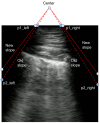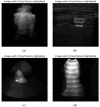COVID-Net L2C-ULTRA: An Explainable Linear-Convex Ultrasound Augmentation Learning Framework to Improve COVID-19 Assessment and Monitoring
- PMID: 38475199
- PMCID: PMC10933837
- DOI: 10.3390/s24051664
COVID-Net L2C-ULTRA: An Explainable Linear-Convex Ultrasound Augmentation Learning Framework to Improve COVID-19 Assessment and Monitoring
Abstract
While no longer a public health emergency of international concern, COVID-19 remains an established and ongoing global health threat. As the global population continues to face significant negative impacts of the pandemic, there has been an increased usage of point-of-care ultrasound (POCUS) imaging as a low-cost, portable, and effective modality of choice in the COVID-19 clinical workflow. A major barrier to the widespread adoption of POCUS in the COVID-19 clinical workflow is the scarcity of expert clinicians who can interpret POCUS examinations, leading to considerable interest in artificial intelligence-driven clinical decision support systems to tackle this challenge. A major challenge to building deep neural networks for COVID-19 screening using POCUS is the heterogeneity in the types of probes used to capture ultrasound images (e.g., convex vs. linear probes), which can lead to very different visual appearances. In this study, we propose an analytic framework for COVID-19 assessment able to consume ultrasound images captured by linear and convex probes. We analyze the impact of leveraging extended linear-convex ultrasound augmentation learning on producing enhanced deep neural networks for COVID-19 assessment, where we conduct data augmentation on convex probe data alongside linear probe data that have been transformed to better resemble convex probe data. The proposed explainable framework, called COVID-Net L2C-ULTRA, employs an efficient deep columnar anti-aliased convolutional neural network designed via a machine-driven design exploration strategy. Our experimental results confirm that the proposed extended linear-convex ultrasound augmentation learning significantly increases performance, with a gain of 3.9% in test accuracy and 3.2% in AUC, 10.9% in recall, and 4.4% in precision. The proposed method also demonstrates a much more effective utilization of linear probe images through a 5.1% performance improvement in recall when such images are added to the training dataset, while all other methods show a decrease in recall when trained on the combined linear-convex dataset. We further verify the validity of the model by assessing what the network considers to be the critical regions of an image with our contribution clinician.
Keywords: COVID-19 assessment; deep explainable architecture; linear–convex augmentation; lung ultrasonic imaging.
Conflict of interest statement
The authors declare no conflict of interest.
Figures







Similar articles
-
COVID-Net USPro: An Explainable Few-Shot Deep Prototypical Network for COVID-19 Screening Using Point-of-Care Ultrasound.Sensors (Basel). 2023 Feb 27;23(5):2621. doi: 10.3390/s23052621. Sensors (Basel). 2023. PMID: 36904833 Free PMC article.
-
COVID-Net Biochem: an explainability-driven framework to building machine learning models for predicting survival and kidney injury of COVID-19 patients from clinical and biochemistry data.Sci Rep. 2023 Oct 9;13(1):17001. doi: 10.1038/s41598-023-42203-0. Sci Rep. 2023. PMID: 37813920 Free PMC article.
-
DIY AI, deep learning network development for automated image classification in a point-of-care ultrasound quality assurance program.J Am Coll Emerg Physicians Open. 2020 Mar 1;1(2):124-131. doi: 10.1002/emp2.12018. eCollection 2020 Apr. J Am Coll Emerg Physicians Open. 2020. PMID: 33000024 Free PMC article.
-
Use of Artificial Intelligence and Machine Learning in Critical Care Ultrasound.Crit Care Clin. 2025 Jul;41(3):593-608. doi: 10.1016/j.ccc.2025.02.008. Epub 2025 Apr 7. Crit Care Clin. 2025. PMID: 40484623 Review.
-
COVID-19 diagnosis: A comprehensive review of pre-trained deep learning models based on feature extraction algorithm.Results Eng. 2023 Jun;18:101020. doi: 10.1016/j.rineng.2023.101020. Epub 2023 Mar 16. Results Eng. 2023. PMID: 36945336 Free PMC article. Review.
Cited by
-
Artificial Intelligence (AI) Applications for Point of Care Ultrasound (POCUS) in Low-Resource Settings: A Scoping Review.Diagnostics (Basel). 2024 Aug 1;14(15):1669. doi: 10.3390/diagnostics14151669. Diagnostics (Basel). 2024. PMID: 39125545 Free PMC article.
References
-
- World Health Organization . Recommendations for National SARS-CoV-2 Testing Strategies and Diagnostic Capacities: Interim Guidance, 25 June 2021. World Health Organization; Geneva, Switzerland: 2021. Technical Report.
-
- World Health Organization . Use of Chest Imaging in COVID-19: A Rapid Advice Guide, 11 June 2020. World Health Organization; Geneva, Switzerland: 2020. Technical Report.
-
- MacLean A., Abbasi S., Ebadi A., Zhao A., Pavlova M., Gunraj H., Xi P., Kohli S., Wong A. Domain Adaptation and Representation Transfer, and Affordable Healthcare and AI for Resource Diverse Global Health. Springer; Berlin/Heidelberg, Germany: 2021. COVID-Net US: A Tailored, Highly Efficient, Self-Attention Deep Convolutional Neural Network Design for Detection of COVID-19 Patient Cases from Point-of-care Ultrasound Imaging; pp. 191–202.
MeSH terms
LinkOut - more resources
Full Text Sources
Medical
Research Materials

